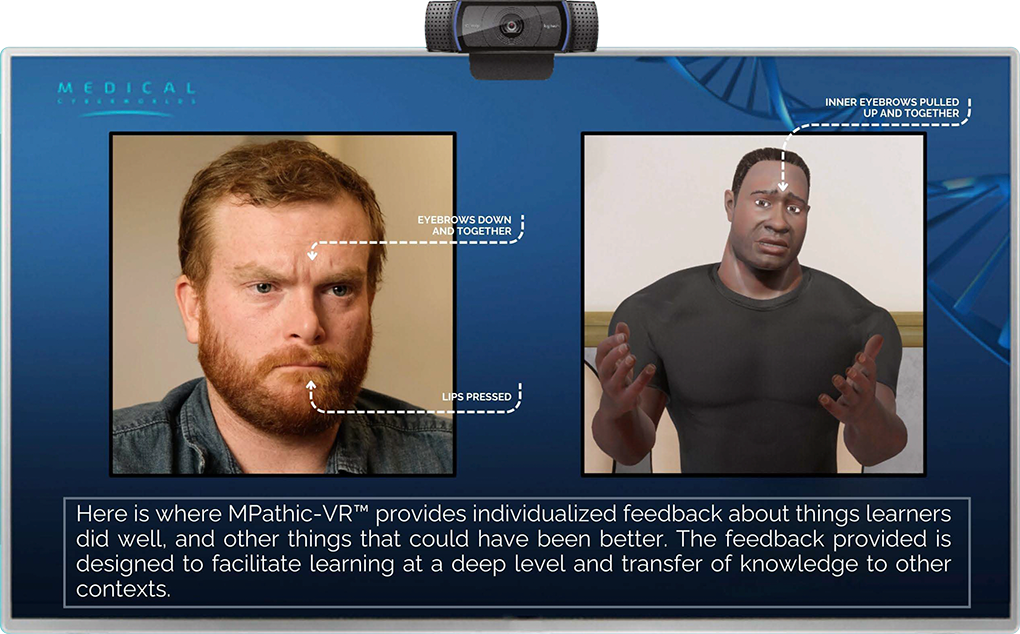THE PROBLEM
Without EI, Communication Fails
Leading to Bad Outcomes
Because Training Emotional Intelligence
Skills is Complex
EFFECTIVE TRAINING INVOLVES:
SOCIAL AWARENESS
Are we aware of our environment, its cultures, societal norms, problems and struggles, and do we know how to deal adaptively and effectively in the environment?
EMOTIONS
Are we aware of the signals others are conveying about their emotions? What do we observe in their Body Language, Manner of Speech and Facial Expressions? And how accurately are we perceiving our own emotions?
BEHAVIORS
How are our feelings, beliefs and biases “leaking out” in our behaviors? To what extent are we aware of our own body language, manner of speech and facial expressions, and how they affect others?
THINKING
How are we using our emotions, our understanding of others’ emotions, of the environment, and of our behaviors, to effectively guide our thinking and actions, and to regulate the emotional reactions of others?
SOCIAL AWARENESS
Are we aware of our environment, its cultures, societal norms, problems and struggles, and do we know how to deal adaptively and effectively in the environment?
EMOTIONS
Are we aware of the signals others are conveying about their emotions? What do we observe in their Body Language, Manner of Speech and Facial Expressions? And how accurately are we perceiving our own emotions?
BEHAVIORS
How are our feelings, beliefs and biases “leaking out” in our behaviors? To what extent are we aware of our own body language, manner of speech and facial expressions, and how they affect others?
THINKING
How are we using our emotions, our understanding of others’ emotions, of the environment, and of our behaviors, to effectively guide our thinking and actions, and to regulate the emotional reactions of others?
THE SOLUTION
MPathic-VRTM
The Transformative Power of Uniting Computer Vision and Ai with Evidence-Based Design
EXPERIENCE
The system provides experience through AI-enabled Simulated Human (SH) interaction. The interactions are emotionally charged and vetted by experts for realism. They mirror the challenging real-life environments and situations in which learners will find themselves.EXPERIENCE
The system provides experience through AI-enabled Simulated Human (SH) interaction. The interactions are emotionally charged and vetted by experts for realism. They mirror the challenging real-life environments and situations in which learners will find themselves.
FEEDBACK
While learners and the SH talk together, MPathic-VR™ uses Computer Vision and AI to capture and analyze learners' behaviors. The system then uses these data to drive real-time virtual human responses and provide learners with personalized feedback, which includes annotated video of them talking with the SH.FEEDBACK
While learners and the SH talk together, MPathic-VR™ uses Computer Vision and AI to capture and analyze learners' behaviors. The system then uses these data to drive real-time virtual human responses and provide learners with personalized feedback, which includes annotated video of them talking with the SH.
REFLECTION
The system then encourages learners to reflect on the experience and on their performance in it. Did they understand the Body Language, Manner of Speech and Facial Expressions of the SH? What were they feeling? What was unconsciously revealed about their feelings by their own behaviors?REFLECTION
The system then encourages learners to reflect on the experience and on their performance in it. Did they understand the Body Language, Manner of Speech and Facial Expressions of the SH? What were they feeling? What was unconsciously revealed about their feelings by their own behaviors?
THINKING
Learners then think about their strengths and weaknesses, develop new ideas and determine what actions they might take to drive better outcomes.THINKING
Learners then think about their strengths and weaknesses, develop new ideas and determine what actions they might take to drive better outcomes.
PRACTICE
Learners can repeat the interaction and apply their new ideas... and the system ADAPTS to what they do differently each time. Ongoing practice over time solidifies concepts and builds skills that transfer into the workplace.PRACTICE
Learners can repeat the interaction and apply their new ideas... and the system ADAPTS to what they do differently each time. Ongoing practice over time solidifies concepts and builds skills that transfer into the workplace.






